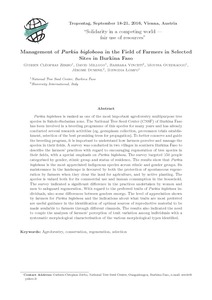Resource information
Parkia biglobosa is ranked as one of the most important agroforestry multipurpose tree species in Sahelo-Sudanian zone. The National Tree Seed Center (CNSF) of Burkina Faso has been involved in a breeding programme of this species for many years and has already conducted several research activities (eg. germplasm collection, provenance trials establishment, selection of the best promising trees for propagation). To better conserve and guide the breeding program, it is important to understand how farmers perceive and manage the species in their fields. A survey was conducted in two villages in southern Burkina Faso to describe the farmers' practices with regard to encouraging regeneration of tree species in their fields, with a special emphasis on Parkia biglobosa. The survey targeted 150 people categorised by gender, ethnic group and status of residence. The results show that Parkia biglobosa is the most appreciated indigenous species across ethnic and gender groups. Its maintenance in the landscape is favoured by both the protection of spontaneous regeneration by farmers when they clear the land for agriculture, and by active planting. The species is valued both for its commercial use and human consumption in the household. The survey indicated a significant difference in the practices undertaken by women and men to safeguard regeneration. With regard to the preferred traits of Parkia biglobosa individuals, also some differences between genders emerge. The level of appreciation shown by farmers for Parkia biglobosa and the indications about what traits are most preferred are useful guidance in the identification of optimal sources of reproductive material to be made available to farmers through different channels. The results also indicated the need to couple the analyses of farmers' perception of trait variation among individuals with a systematic morphological characterisation of the various morphological types identified.


